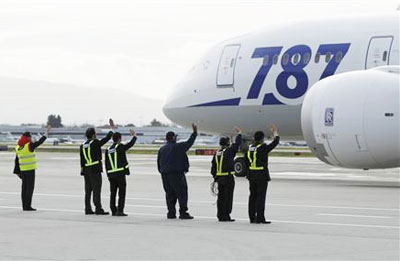
US experts in Japan for Boeing 787 probe
Tokyo, January 18, 2013
A team of experts from US aviation authorities and Boeing arrived in Japan on Friday to inspect a 787 Dreamliner passenger jet that made an emergency landing on a domestic All Nippon Airways Co flight earlier this week.
The incident prompted regulators in the US and around the world to ground the 50 Dreamliners already in service. Battery-related problems are being investigated after warning lights indicated a battery fault on the ANA flight on Wednesday.
The 787, a lightweight, mainly carbon-composite aircraft, has been plagued by mishaps, raising concerns over its use of lithium-ion batteries, which pack more energy and are faster to recharge but which are potentially more volatile.
The five representatives from the US National Transportation Safety Board (NTSB), Federal Aviation Administration (FAA) and Boeing are helping Japanese authorities in the investigation of the aircraft, which remains parked at the side of Takamatsu airport in western Japan.
The Japan Transport Safety Board (JTSB) aims to end its initial checks by around midday on Saturday, a person familiar with the matter told Reuters.
"The Boeing 787 is an absolutely wonderful aircraft and we will spare no effort to help it get back in the air safely as soon as possible," said ANA spokesman Hideya Oishi.
GS Yuasa Corp, the Japanese company that makes batteries for the Dreamliner, said it also sent three engineers to Takamatsu to help the investigation.
A person at the company, who asked not to be named due to the sensitivity of the issue, said: "Our company's battery has been vilified for now, but it only functions as part of a whole system. So we're trying to find out exactly where there was a problem within the system."
Shares in the Kyoto-based battery maker rose 3 per cent on Friday, having dropped around 18 per cent since January 7 when a battery caught fire in the auxiliary power unit (APU) of a Japan Airlines (JAL) 787 parked at Boston Logan International Airport.
The US investigation into that incident is focused for now on the Japanese-made batteries, with no indication the APU - built by United Technologies Corp's Pratt & Whitney - was involved, said a person familiar with the government probe, who was not authorized to speak publicly.
Laura Brown, a spokeswoman for the FAA in Washington, said she could not comment as the issue was part of the investigation.
Mark Rosenker, a retired Air Force two-star general who served as chairman of the NTSB under former President George W. Bush, said US investigators, Boeing experts and the battery maker were conducting a meticulous investigation of what caused the lithium-ion batteries to fail. "This is a very complex issue that has tremendous ramifications."
He said Boeing conducted over 1.3 million hours of testing before deciding the lithium-ion batteries were safe to use on the 787, and the company had to satisfy additional rigorous tests to be granted "special condition" by the FAA for use of the batteries.
"I don't believe there was corner cutting in any way," he said. "I believe the FAA has done a good job in its certification process. And Boeing is a very formidable and extremely careful airplane manufacturer. You don't survive in this business by not making safe, efficient and reliable planes," he added.-Reuters







